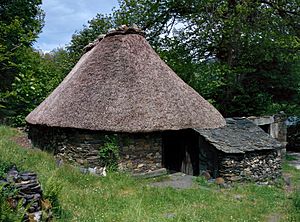Teito facts for kids
A Teito is a special kind of house found in parts of Spain and Portugal. Imagine a sturdy stone building with a thick, cozy roof made of straw or broom plants. These unique homes are mostly seen in western Asturias and Galicia in Spain, and also in the northern parts of León and northeastern Portugal.
The word teito actually means "roof" in the Asturian language. However, people use it to describe the whole building because the roof is such a big and important part of it! In Asturias and León, people usually say "teito." But if you go to Galicia or the Ancares area of León, you'll hear them call these houses "palloza." In Portugal, they are sometimes called "Palhoça."
Contents
What is a Teito House?
A Teito house is a traditional building designed to keep people and animals warm and safe. These homes are built using materials found right in the local area.
Strong Stone Walls
The main part of a Teito house is built with strong stone walls. These walls are thick and sturdy, helping to keep the inside cool in summer and warm in winter. They are built to last a very long time, often for hundreds of years.
Thatched Roofs
The most special part of a Teito is its roof. It's made from natural materials like straw, rye, or broom plants. These materials are carefully layered to create a thick, waterproof, and insulating roof. This type of roof is called a "thatched roof." It helps protect the house from rain, snow, and strong winds.
How are Teito Roofs Made?
Building a thatched roof is a skilled job. Workers carefully tie bundles of straw or broom together and then layer them onto the roof frame. Each layer overlaps the one below it, like shingles, to make sure water runs off easily. This traditional method has been passed down through many generations.
Where Can You Find Teito Houses?
Teito houses are found in specific mountainous and rural areas. These regions often have a lot of rain and snow, making the strong, insulating design of the Teito very useful.
Teitos in Asturias
In Asturias, especially in places like Somiedo and Oscos, you can see many Teito houses. These areas are known for their beautiful landscapes and traditional ways of life. The Teitos fit perfectly into the natural surroundings.
Pallozas in Galicia and León
When you go to Galicia or the northwestern part of León, particularly in the Ancares mountains, these houses are called "pallozas." They are very similar to Teitos but have their own local style. Pallozas often have a round or oval shape, which makes them look like ancient homes.
Palhoças in Portugal
Across the border in northeastern Portugal, you might find similar buildings called "Palhoças." This shows how traditional building styles can be shared across different regions and countries, especially when they have similar climates and available materials.
Why Were Teitos Built?
Teito houses were built to meet the needs of farming families in the past. They were designed to be practical and efficient.
Homes for Families
These houses were not just for people. Often, the ground floor of a Teito or Palloza was used to keep farm animals like cows or horses. The heat from the animals helped to warm the living area upstairs, which was a clever way to stay warm during cold winters.
Keeping Warm and Dry
The thick stone walls and thatched roofs were excellent for insulation. They kept the inside of the house warm in winter and cool in summer. This was very important in areas with harsh weather conditions.
Using Local Materials
Building a Teito meant using materials that were easy to find nearby. Stones from the mountains and straw or broom from the fields were free and plentiful. This made them a sustainable and affordable way to build homes for many centuries.
Teitos Today
While many Teitos are no longer used as homes, some have been preserved. Some are now museums, showing visitors what life was like in these traditional houses. Others have been restored and are used as guesthouses or tourist attractions, allowing people to experience their unique charm. Preserving these buildings helps us remember the history and culture of the people who lived in them.
See also
 In Spanish: Teito para niños
In Spanish: Teito para niños


